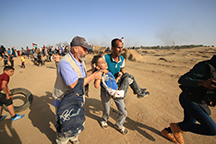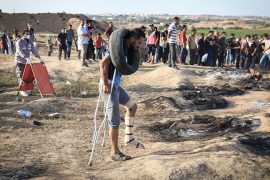The Gaza Strip: Protest, Violence & Pain

 Motaz Al Azayza, 19, is a student at the Al-Azhar University in
Motaz Al Azayza, 19, is a student at the Al-Azhar University in
the Gaza Strip. Motaz is a freelance portrait photographer. He is
majoring in English translation.
He’s also a volunteer paramedic with the Red Crescent Organization.
For several weeks now, Motaz has been busy, due to the controversial decla-
ration of Jerusalem as the capital of Israel by President Trump.
“I heard news about the casualties happening all over in Westbank and the
Gaza strip, Red Crescent was requiring volunteers” he said. “I wanted to help
my people, I wanted to protest by helping save lives of these protestors.” he
said.
Motaz said Palestinians don’t deserve the situation they are in today.
On May 14, the United States embassy opened in Jerusalem, relocated from
the city of Tel Aviv. The U.S., among many other nations, has opposed the
recognition of Jerusalem as the capital of Israel, since the state’s founding in
1948.
The embassy was moved as a result of The Jerusalem Embassy Act of 1995.
The purpose of the act was to move the embassy at the end of the 90s. The
U.S. Senate passed the resolution of Jerusalem embassy act, urging the presi-
dent to follow according to the Senate’s resolution.
However, the movement has been postponed by several past presidents, via
a six-month waiver.
The latest waiver occurred last December.
“I was standing by the ambulance with a colleague when I heard the blast,”
Motaz said. “Everything went blur in front of my eyes, I couldn’t feel my legs.
The next thing I know, I was in the back of our ambulance being carried to
the hospital.”
Motaz was shot by a tear-gas bomb on his left femur during a protest
against the Israeli occupation.

On June 22nd, right after prayers, Motaz rode with a colleague to the East
Al-Buriji border, in Gaza. “It was getting crowded very quickly, people were
carrying tires to light them on fire and create visual blockade against the
Israeli snipers,” he said.
Protestors brought handmade catapults to throw stones across the border
towards the Israeli armed force. Minutes into the protest, Israelis replied
with tear gas and live fire, injuring hundreds. Among the chaos Motaz saw
one protestor hit by a sniper shot very near to his ambulance, he ran with a
stretcher while a tear gas bomb hit his left femur.
The formal recognition of Jerusalem as Israel’s capital happened last De-
cember. President Trump, criticizing decades of foreign policy said, “It would
be folly to assume that repeating the exact same formula would now produce
a different or better result.”
The announcement followed by an emergency general assembly by the U.N.
as an attempt to stop the United States embassy move.
Trump threatened to cut off foreign aid against those that would oppose
their decision, the votes strongly rejected the U.S. with the result of 128 to 9.
After the vote, the UN declared the December recognition of Jerusalem as
“Null and void.”
The debate has rages because both Israelis and Palestinians see Jerusalem
as their Capital. Trump’s announcement, which allowed Israel to gain interna-
tional recognition, reinforced the Israeli belief of their right for a Jewish state,
which has so far in history been observed by Israelis expanding the West
Bank.
For Palestinians the move ends their hopes of a independent Palestinian
State with East Jerusalem as its capital.
Since the start of the Israeli occupation in Gaza, the economy of the small
area has collapsed. According to a recent World Bank report, Israeli block-
ades, war and poor governance has left 43 percent of Gazans out of jobs, and
placed the area in a financial crisis.
The fall in unemployment brought fear among young students and college
graduates. Hammad, whose name has been changed due to security concerns,
is a student at the Al-Azhar University of Gaza. Because he doesn’t have a job,
he comes to the protest every week.
“Jerusalem is not only for the Israelis, it’s our land as well,” he said.
Hammad believes taking Jerusalem is another step forward for Israelis to
occupy all over Palestine. “They took away jobs, killed so many lives and now
they want to occupy the whole land,” he said.
Mohammed Al Kharobi, a Gazan, has lost his entire life earning during
the verge of economic downfall last year. He joins the protestors every Friday
after prayers.
Risking his life in front of Israeli snipers, doesn’t scare him anymore. He
believes there will never be a solution.
“I want to get shot, so that I can get government fund to feed myself and my
kids,” he said.
Mohammed blames the Israeli occupation, the armed blockades and the
fear of war for the current economic disaster in Gaza. “I don’t have a job, but I
need money to survive. If I dont, I die. I am not afraid of death,” he said.
A WHO report stated since the start of the conflict, there have been 145
deaths and over 16,000 injuries in the occupied Palestinian Territory and
Gaza.
Omar Al Azaiza, manager of Palestinian Red Crescent Society, said most of
the deaths were from sniper shots and live firing.
“We often run out of ambulances to carry the injured to the hospital,” he
said. Most of the paramedics working for him are volunteers and often it’s
hard to find more paramedics since there are no paid positions.
Often snipers shoot at ambulances, Omar says that neither him nor his
team is afraid of death. But as the protest drags on, the Red Crescent Society
is running out of resources to help the injured.
“We often don’t have money for buying patrol for the ambulances, we need
help,” Omar said.
Still, more and more civilians are joining the protestors at the border.
The major goal for Palestinian is to have the blockade lifted.
Israel claims a blockade is necessary to protect its citizens from “terrorism,
rocket attacks and any other hostile activity” and to prevent materials to be
imported into Gaza that could potentially be used to make weapons.
The frustrations of the Palestinians has sparked many reactions over the
years in the forms of protests and rocket launches.
Since 2001, Palestinians have launched thousands of rockets from the Gaza
Strip. Those attacks have injured thousands and killed both Israelis and Pales-
tinians.
Sderot, a city of approximately 22,000 residents, serves as a case study for
the psychological implications of sustained rocket and mortar attacks. Several
different studies have examined the impact of the violence on children.
The studies indicate that more than 50 percent of children in the area are
suffering of post traumatic stress. Other illness includes depression, anxiety,
miscarriages, and health issues correlated with constant stress of possible
rockets launching.
International attempts to solve the Israeli-Palestine conflicts has been
ongoing for decades. The Israeli-Palestinian peace process includes America’s
effort to create states for both populations.
The two st
ate solution would establish Palestine as an independent state in
Gaza and the West Bank. A more controversial solution, the one state version,
would make the entire area as a single country, either Israel or Palestine.
There are countless issues, communication errors, general distrust, and
the promise to both entities made by other nations, that make any resolution
almost impossible.
For Motaz, the photographer, solice is found in photography. He is a couple
years away from finishing college, but his work as a photographer has im-
pressed many Gazans.
“I want to pursue photography as a career, but with the current situation
I don’t think I can pursue my dream in Gaza,” he said. “I want to get out of
here, go abroad and learn more.”
That may prove difficult. Gaza is under a complete blockade, Motaz’s hopes
of seeing the outside world are dim.